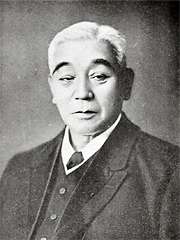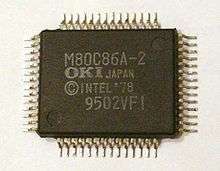OKI (conglomerate company)
Oki Electric Industry Co., Ltd. (沖電気工業株式会社, Oki Denki Kōgyō Kabushiki-gaisha), commonly referred to as OKI, OKI Electric or the OKI Group, is a Japanese company manufacturing and selling info-telecom and printer products. Headquartered in Toranomon, Minato-ku, Tokyo,[4] OKI operates in over 120 countries around the world.
.svg.png) | |
 Headquarters in Toranomon First Garden | |
| Public KK | |
| Traded as | TYO: 6703 Nikkei 225 Component |
| ISIN | JP3194000000 |
| Industry | Electronics |
| Founded | January 1881 |
| Founder | Kibataro Oki |
| Headquarters | 1-7-12 Toranomon, Minato-ku, Tokyo 105-8460, Japan 35°40′11″N 139°44′58″E |
Key people | Hideichi Kawasaki (President and CEO) |
| Products | |
| Revenue | |
Number of employees | 21,090 (consolidated, as of March 31, 2014) |
| Website | oki |
| Footnotes / references [1][2][3] | |
OKI manufactured the first telephone in Japan in 1881, and now specializes not only in developing and manufacturing telecommunication equipment but also in information products and mechatronics products, such as Automated teller machine (ATMs) and printers. Its printer business is operated through OKI Data, under the brand name OKI. OKI had a semiconductor business, which it spun off and sold to Rohm Company, Limited on October 1, 2008.
OKI Data Group, which markets its products under the OKI brand, is focused on creating professional printed communications products, applications and services. The OKI Data Group provides a wide range of devices, from printers, faxes and multi-functional products to business applications and consultancy services.
OKI Data Americas also markets the OKI proColor Series, a line of digital production printers designed specifically for the graphic arts and production market in North America to offer print solutions for color-critical applications.
Company history
OKI of telecommunication (1881–1950s)
Founding
The company was founded by Kibataro Oki (1848–1906) an engineer formerly employed at a Kobusho (Ministry of Industry) factory. In 1877, only a year after Graham Bell's invention, Kubusho had started an effort to make telephone receivers by reverse engineering and Oki was in the team that came up with the first prototype.[5] In January 1881, convinced that the nation was about to enter the age of communications, Kibataro Oki founded Meikōsha, which was later renamed OKI. The company manufactured the first telephone in Japan in 1881, only five years after Bell invented the phone, and presented a silver-award-winning lacquer-coated wire at the 1885 International Inventions Exhibition in London.[6]
Early years
OKI contributed immensely to the spread of phones in Japan under the country’s Telephone Expansion Plans. The company not only focused on telephones, but saw the need of automatic exchanges as phones became more common.[7] Asano Soichiro of Asano zaibatsu elected chairman in 1912.[8]

Pre and post wars
During World War I, wartime demand brought large profits to OKI as demand for telephone service increased. A strong demand emerged for PBXs (Private Branch Exchange) and at that time, OKI installed the largest PBX system in Japan. In addition to business from Japan, overseas business also grew, providing railroad-type printers, portable telephones and electric wires outside Japan. From around 1920, OKI achieved notable advances in its technical development of the common-battery switchboard. Asano Soichiro's son Soichiro (Asano Taijiro) of Asano zaibatsu appointed chairman in 1931.[9]
In the late 1930s, OKI’s plants were used towards meeting the military demand for goods having a major influence on OKI’s business. Based on this demand, OKI built new production plants, increased its capital and increased the number of its affiliates.
Though OKI increased its production capacity after the war to restore magnetotype telephones and exchanges that were damaged during the war, OKI endured great difficulties as it moved toward rebuilding itself. On November 1, 1949, Oki Electric Industry Co., Ltd. (today’s OKI) was established to replace the former Oki Electric Co., Ltd. And the two years later in November 1951, OKI’s shares were listed on the Tokyo Stock Exchange. It was also at this time when OKI started mass-producing the “Type-4 telephone,” which was called the "symbol of Japan’s postwar reconstruction. OKI was also aware of learning new telecommunication technologies, and in 1956, it was the first to produce a 100-line Ericsson-type crossbar-switching systems for commercial use.
OKI of electronics (1960s-1980s)
OKI gradually transformed itself into an electronics company from the second half of 1960s into the 1970s.
1960s
To respond to the high-level economic growth Japan was experiencing, OKI needed to speed up its business operations and clarify responsibilities. OKI began producing and supplying business machines such as Teletypewriters, and perforation typewriters. In June 1961, OKI launched OKITYPER2000, an electric teletypewriter that could simultaneously make perforation tapes and book entry forms. The company also developed and sold various general-purpose computers such as OKITAC-5090, the first domestically produced computer to use core memory.
In 1964 OKI developed OKISAVER, a terminal for online deposits which was provided to financial institutions.
1970s
In addition to minicomputers such as OKITAC series developed in the mid-1960s, OKI began supplying various I/O devices, electroprinters, and dot printers, mainly to the financial industry in the 1970s. OKI’s business at this time included cash dispensers (CDs), automatic depositors(ADs) and automated teller machines (ATMs).
It was at this time when OKI expanded its overseas business providing telecommunication systems to countries in the Middle East, Central and South American countries as well as other Asian countries. In 1972, OKI established Oki Data Corporation (ODC: today’s OKI Data Americas), a Japan-US joint venture in Philadelphia, to develop the DP100, dot printers.
Around that time in 1975, OKI developed the world’s first automobile telephone system together with Bell Labs. This was the beginning of OKI’s wireless technology, and today (as of 2009) OKI expands this technology into vehicle-to-vehicle communications and other ETC (Electronic toll collection) technologies.
1980s

In May 1980, OKI launched its IF-800 series,[10] which was a successful business-use PC business. It also added a facsimile business unit to develop private sector demand. In 1982, OKI introduced the world’s first cash-recycling ATM, allowing deposited banknotes to be immediately used for withdrawal.

- Printers
- Microline
- 80, 82/83, 84, 92/93
- 180, 182/183, 190, 192/193
- 280, 292/293, 294
- 320 FB, 321, 380, 390 FB, 393, 395
- 520/521, 590/591
- Okimate 10, 20
- Pacemark
- 2350, 2410
- 3410, 4410
- Laserline 6
- ICs
- MSM5232 8-channel tone generator
- MSM6242 RTC
- MSM6295 4-channel ADPCM
OKI of network solutions (1990s)
In the early 90s, Japanese economy was in the midst of recession that continued after the bubble economy collapsed, which also hit a strong blow to OKI’s business. In October 1994, OKI spun off its printer and facsimile business, and established Oki Data Corporation. In the later 90’s, with the spread of the Internet, OKI worked on being recognized as the company that offers network solutions.
2000s
In 2004, OKI released its IP CONVERGENCE Server SS9100, the industry’s first Microsoft.Net-compliant server, and in 2006, released its Center Stage NX5000, a carrier-grade communication server compliant with next-generation networks.
In 2008, as part of its business selection and concentration measures, OKI spun off its semiconductor business to Rohm Co., Ltd.
Subsidiaries
Oki Data Americas, Inc., a subsidiary of Oki Data Corporation of Japan, produces PC peripheral equipment under the OKI brand, including digital color and monochrome printers, serial impact dot matrix printers, multifunction products and facsimiles.
Oki Data Americas can be traced back to 1972 when the company was founded as a joint venture between two Philadelphia entrepreneurs and their Japanese customer, Oki Electric to develop and produce information technology products. One of its popular products was the Okimate 10 thermal transfer printer, one of the first affordable color printers for early home computers.
Oki Data Americas, Inc. is headquartered in Irving, Texas. Other Oki Data Americas offices are in Mississauga, Canada; Mexico City, Mexico; and São Paulo, Brazil.
Sponsoring
Oki sponsored English Premier League football club Portsmouth F.C. from 2005 to 2009. From 2003 to 2008, Oki owned the naming rights to OKI Jubilee Stadium in Kogarah, New South Wales, Australia, which houses the NRL team St. George Illawarra Dragons. OKI was also the major sponsor of 1.FC Kaiserslautern from 1990 to 1996. During the 1998-1999 season OKI sponsored the French Ligue 1 team HSC Montpellier.
Gallery
 OKI manufacturing plant in Cumbernauld, Scotland
OKI manufacturing plant in Cumbernauld, Scotland The headquarters of Oki Electric Cable in Nakahara-ku, Kawasaki
The headquarters of Oki Electric Cable in Nakahara-ku, Kawasaki An OKI colour multifunction printer
An OKI colour multifunction printer Compact ATM of the predecessor installed at Lawson
Compact ATM of the predecessor installed at Lawson
References
- "Corporate Profile". Retrieved August 15, 2014.
- "OKI Electric Financial Statements". Bloomberg Businessweek. Retrieved August 15, 2014.
- "OKI Annual Report 2013" (PDF). Retrieved August 15, 2014.
- "Corporate Profile." Oki Electric Industry. Retrieved on March 12, 2019. "Head Office [...] 1-7-12 Toranomon, Minato-ku, Tokyo, 105-8460, Japan" - Japanese address: "本社: 東京都港区虎ノ門1-7-12(電話: 03-3501-3111 大代表)" map
- Odagiri, Hiroyuki (1996). Technology and Industrial Development in Japan. Clarendon Press, Oxford. p. 137. ISBN 0-19-828802-6.
- "1874 - 1939". OKI Global. Retrieved 24 March 2012.
- https://www.oki.com/en/profile/history/pdf/OkiHe2.pdf The 120-Year History of Oki Electric
- https://www.oki.com/en/profile/history/his_1.html OKI
- https://www.oki.com/en/profile/history/his_1.html OKI
- The View from Japan, InfoWorld, July 7, 1980, p. 1
External links
- Main Corporate Site
- OKI Data Americas
- OKI chip pictures at chipdb.org
- Oki Data Americas, Background
- Oki Data Americas, proColor Series
- Oki Electric Industry Company, Limited Company Profile - on Yahoo! Finance